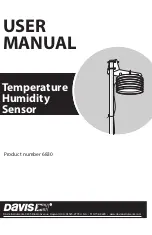
108
c
HAPTER
6:
Computer Interface Operation
Model 336 Temperature Controller
6.3.4.1 Character Format
A character is the smallest piece of information that can be transmitted by the inter-
face. Each character is ten bits long and contains data bits, bits for character timing,
and an error detection bit. The instrument uses seven bits for data in the American
Standard Code for Information Interchange (ASCII) format. One start bit and one stop
bit are necessary to synchronize consecutive characters. Parity is a method of error
detection. One parity bit configured for odd parity is included in each character.
ASCII letter and number characters are used most often as character data. Punctua-
tion characters are used as delimiters to separate different commands or pieces of
data. A special ASCII character, line feed (LF 0AH), is used to indicate the end of a mes-
sage string. This is called the message terminator. The Model 336 will accept either
the line feed character alone, or a carriage return (CR 0DH) followed by a line feed as
the message terminator. The instrument query response terminator will include both
carriage return and line feed.
6.3.4.2 Message Strings
A message string is a group of characters assembled to perform an interface function.
There are three types of message strings: commands, queries, and responses. The
computer issues command and query strings through user programs, the instrument
issues responses. Two or more command or query strings can be chained together in
one communication, but they must be separated by a semi-colon (;). The total com-
munication string must not exceed 255 characters in length.
A command string is issued by the computer and instructs the instrument to perform
a function or change a parameter setting. The format is:
<command mnemonic><space><parameter data><terminators>.
Command mnemonics and parameter data necessary for each one is described in
section 6.6. Terminators must be sent with every message string.
A query string is issued by the computer and instructs the instrument to send a
response. The query format is:
<query mnemonic><?><space><parameter data><terminators>.
Query mnemonics are often the same as commands with the addition of a question
mark. Parameter data is often unnecessary when sending queries. Query mnemonics
and parameter data if necessary is described in section 6.6. Terminators must be sent
with every message string. The computer should expect a response very soon after a
query is sent.
A response string is the instrument’s response or answer to a query string. The
response can be a reading value, status report or the present value of a parameter.
Response data formats are listed along with the associated queries in section 6.6. The
response is sent as soon as possible after the instrument receives the query.
6.3.5 Message Flow
Control
It is important to remember that the user program is in charge of the USB communi-
cation at all times. The instrument cannot initiate communication, determine which
device should be transmitting at a given time, or guarantee timing between mes-
sages. All of this is the responsibility of the user program.
When issuing commands the user program alone should:
D
Properly format and transmit the command including the terminator as 1 string
D
Guarantee that no other communication is started for 50 ms after the last char-
acter is transmitted
D
Not initiate communication more than 20 times per second
Summary of Contents for 336
Page 4: ...Model 336 Temperature Controller...
Page 6: ...Model 336 Temperature Controller...
Page 26: ...14 cHAPTER 1 Introduction Model 336 Temperature Controller...
Page 54: ...42 cHAPTER 3 Installation Model 336 Temperature Controller...
Page 84: ...72 cHAPTER 4 Operation Model 336 Temperature Controller...
Page 104: ...92 cHAPTER 5 Advanced Operation Model 336 Temperature Controller...
Page 164: ...152 cHAPTER 7 Options and Accessories Model 336 Temperature Controller...
Page 178: ...166 cHAPTER 8 Service Model 336 Temperature Controller...
















































